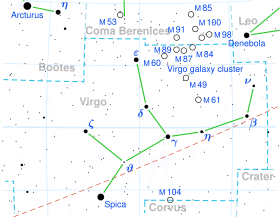피 버진리스
Pi Virginis| 관측 데이터 에폭 J2000 이쿼녹스 J2000 | |
|---|---|
| 별자리 | 처녀자리 |
| 우측 상승 | 12h 00m 52.39042s[1] |
| 탈위임 | +06° 36′ 51.5571″[1] |
| 겉보기 크기 (V) | 4.64[2] |
| 특성. | |
| 스펙트럼형 | A5 V[3] |
| U-B색지수 | +0.12[2] |
| B-V색지수 | +0.12[2] |
| 아스트로메트리 | |
| 방사 속도 (Rv) | -10.4km[4]/s |
| 고유 운동 (μ) | RA: +0.26마스[1]/yr Dec.: -30.10[1] mas/yr |
| 시차 (π) | 8.49 ± 0.39[1] 마스 |
| 거리 | 380 ± 20 리 (105 ± 5 pc) |
| 절대치수 (MV) | −0.70[5] |
| 궤도[6] | |
| 1차 | 처녀자리 A |
| 동반자 | 버진리스 B |
| 기간 (P) | 282.69일 |
| 반주축 (a) | 3.55 마스 |
| 편심성 (e) | 0.265 |
| 기울기 (i) | 62.71° |
| 노드의 경도 (Ω) | 149.34° |
| 페리아스트론 신기원을 이루다 (T) | 2448281.3906 |
| 페리아스트론의 인수 (ω) (2차) | 312° |
| 반암도 (K1) (iii) | 26.20km[7]/s |
| 세부 사항 | |
| π Vir A | |
| 미사 | 2.2[7] M☉ |
| 반지름 | 1.5[8] R☉ |
| 표면 중력 (log g) | 3.51[9] cgs |
| 온도 | 8000K[9] |
| 회전 속도 (v sin i) | 71km[3]/s |
| 기타 지정 | |
| 데이터베이스 참조 | |
| 심바드 | 자료 |
피 버진리스(Pi Virginis, π Virginis)는 처녀자리 별자리의 2진수 별이다.육안으로는 4.64의 외관상으로 볼 수 있다.[2]시차 측정에 근거한 이 별까지의 거리는 대략 380광년이다.[1]
이것은 A5V의 별 분류를 갖는 분광형 2진법이다.그들은 궤도 주기가 283일이고 편심률은 0.27이다.[7]두 별의 질량비율은 약 0.47이며, 1차 질량은 태양의 2.2배 정도로 추정된다.경선은 시원한 메탈릭 계열의 암별이다.[9]
참조
- ^ a b c d e f van Leeuwen, F. (November 2007), "Validation of the new Hipparcos reduction", Astronomy and Astrophysics, 474 (2): 653–664, arXiv:0708.1752, Bibcode:2007A&A...474..653V, doi:10.1051/0004-6361:20078357, S2CID 18759600.
- ^ a b c d Mermilliod, J.-C. (1986), "Compilation of Eggen's UBV data, transformed to UBV (unpublished)", Catalogue of Eggen's UBV Data, Bibcode:1986EgUBV........0M.
- ^ a b Royer, F.; et al. (February 2007), "Rotational velocities of A-type stars. III. Velocity distributions", Astronomy and Astrophysics, 463 (2): 671–682, arXiv:astro-ph/0610785, Bibcode:2007A&A...463..671R, doi:10.1051/0004-6361:20065224, S2CID 18475298.
- ^ Evans, D. S. (June 20–24, 1966), Batten, Alan Henry; Heard, John Frederick (eds.), "The Revision of the General Catalogue of Radial Velocities", Determination of Radial Velocities and their Applications, Proceedings from IAU Symposium no. 30, University of Toronto: International Astronomical Union, vol. 30, p. 57, Bibcode:1967IAUS...30...57E.
- ^ Anderson, E.; Francis, Ch. (2012), "XHIP: An extended hipparcos compilation", Astronomy Letters, 38 (5): 331, arXiv:1108.4971, Bibcode:2012AstL...38..331A, doi:10.1134/S1063773712050015, S2CID 119257644.
- ^ ESA (1997). "The Hipparcos and Tycho Catalogues". VizieR On-line Data Catalog. Bibcode:1997yCat.1239....0E.
- ^ a b c Ducati, J. R.; et al. (January 2011), "The mass ratio and initial mass functions in spectroscopic binaries" (PDF), Astronomy and Astrophysics, 525: 9, Bibcode:2011A&A...525A..26D, doi:10.1051/0004-6361/200913895, A26.
- ^ Pasinetti Fracassini, L. E.; et al. (February 2001), "Catalogue of Apparent Diameters and Absolute Radii of Stars (CADARS) - Third edition - Comments and statistics", Astronomy and Astrophysics, 367 (2): 521–524, arXiv:astro-ph/0012289, Bibcode:2001A&A...367..521P, doi:10.1051/0004-6361:20000451, S2CID 425754.
- ^ a b c Paunzen, E.; et al. (February 2013), "A photometric study of chemically peculiar stars with the STEREO satellites - II. Non-magnetic chemically peculiar stars", Monthly Notices of the Royal Astronomical Society, 429 (1): 119–125, arXiv:1211.1535, Bibcode:2013MNRAS.429..119P, doi:10.1093/mnras/sts318, S2CID 119231581.
- ^ "pi. Vir -- Spectroscopic binary", SIMBAD Astronomical Database, Centre de Données astronomiques de Strasbourg, retrieved 2016-09-16.



